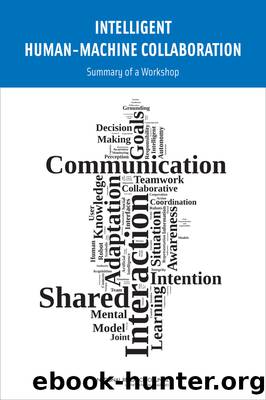Intelligent Human-Machine Collaboration: Summary of a Workshop by M. Chiang

Author:M. Chiang
Language: eng
Format: epub
Tags: ebook
Publisher: The National Academies Press
Published: 2012-09-15T00:00:00+00:00
5
Global and Transnational Issues
There are significant real-world problems, Bradshaw proposed, that by their very nature are international in scope and would benefit by participation from researchers from different countries and different disciplines. Sonenberg added that for many large-scale (and potentially international or global) problems, great opportunities exist for collaboration and coordination to meet shared goals. Today, researchers are tapping into the potential to exploit the Web to collect, integrate, and share data in useful ways to support the flow of data from information to knowledge. In addition, new technological capabilities, such as large-scale and massively distributed sensor systems, are allowing researchers to explore new, and potentially global, scales where the âfieldâ has become the âlaboratory.â
She also referred to the scenario discussions on cross-cultural issues that addressed differing norms regarding âpersonal space,â gender roles and preferences, safety and trust in automation, and communication. Addressing these cultural differences, she noted, would benefit from national and localâas well as globalâexpertise.
From an international manufacturing and assembly collaboration perspective, Don Mottaz described the challenges of translating process information into other languages and cultures. While current efforts focus on teaching humans, he proposed that machines may one day be used to teach humans from a variety of different cultural backgrounds. Thus spoken, written, tactile, and other teaching strategies will help to incorporate cross-cultural human-machine interaction requirements.
Lakmal Seneviratne discussed the increasing global use of automated tools in surgical environments, as well as long-distance teleoperated robotic surgeries. In addition to time zone differences, technological challenges from computer-robot delays (above 1/100 of a second), operating room team dynamics and hierarchies, and social acceptance of robot surgery tools across cultures by both medical practitioners and patients still present significant obstacles.
In addition to robotic surgery applications, Wagner proposed that medical doctors might beam into rural or underserved hospitals and clinics to conduct physical exams and deploy further specialization. He would like to see these tasks move beyond âskype-on-wheels.â Oron-Gilad suggested that environmental context is also an important factor in remote presence. For example, remote participants may not realize that they have beamed into a stressful, unpredictable, or dangerous environment, such as a war zone, thus underappreciating or underutilizing the context in which the local staff is operating.
Ramchurn identified energy management as a global issue in which agents and machines will play a role. As nations shift their focus to renewable energy sources, he suggested, intermittent sources and supply/demand constraints may require agents to have some control of devices (e.g., washing machines) to influence energy usage patterns. In these circumstances, humans would actually be adapting their behavior to agents.
For search and rescue missions, Kruijff commented that cultural considerations come into play when local, national, and regional agencies or organizations need to deliver, share, and coordinate information. For this reason, Tadokoro emphasized multiculturally sensitive data-gathering and -sharing strategies.
Lastly, Sonenberg commented that effectively addressing the social and cultural implications of human-machine collaboration will call for social scientists and anthropologists to work together with engineers. Further, many of these kinds of collaborations will be studied more effectively in natural settings than in the lab.
Download
This site does not store any files on its server. We only index and link to content provided by other sites. Please contact the content providers to delete copyright contents if any and email us, we'll remove relevant links or contents immediately.
Algorithms of the Intelligent Web by Haralambos Marmanis;Dmitry Babenko(16236)
Jquery UI in Action : Master the concepts Of Jquery UI: A Step By Step Approach by ANMOL GOYAL(9389)
Test-Driven Development with Java by Alan Mellor(7736)
Data Augmentation with Python by Duc Haba(7610)
Principles of Data Fabric by Sonia Mezzetta(7380)
Learn Blender Simulations the Right Way by Stephen Pearson(7296)
Microservices with Spring Boot 3 and Spring Cloud by Magnus Larsson(7139)
Hadoop in Practice by Alex Holmes(6589)
RPA Solution Architect's Handbook by Sachin Sahgal(6519)
The Infinite Retina by Robert Scoble Irena Cronin(6217)
Big Data Analysis with Python by Ivan Marin(5936)
Life 3.0: Being Human in the Age of Artificial Intelligence by Tegmark Max(5518)
Pretrain Vision and Large Language Models in Python by Emily Webber(4896)
Infrastructure as Code for Beginners by Russ McKendrick(4654)
Functional Programming in JavaScript by Mantyla Dan(4438)
WordPress Plugin Development Cookbook by Yannick Lefebvre(4384)
The Age of Surveillance Capitalism by Shoshana Zuboff(4249)
Embracing Microservices Design by Ovais Mehboob Ahmed Khan Nabil Siddiqui and Timothy Oleson(4149)
Applied Machine Learning for Healthcare and Life Sciences Using AWS by Ujjwal Ratan(4136)
